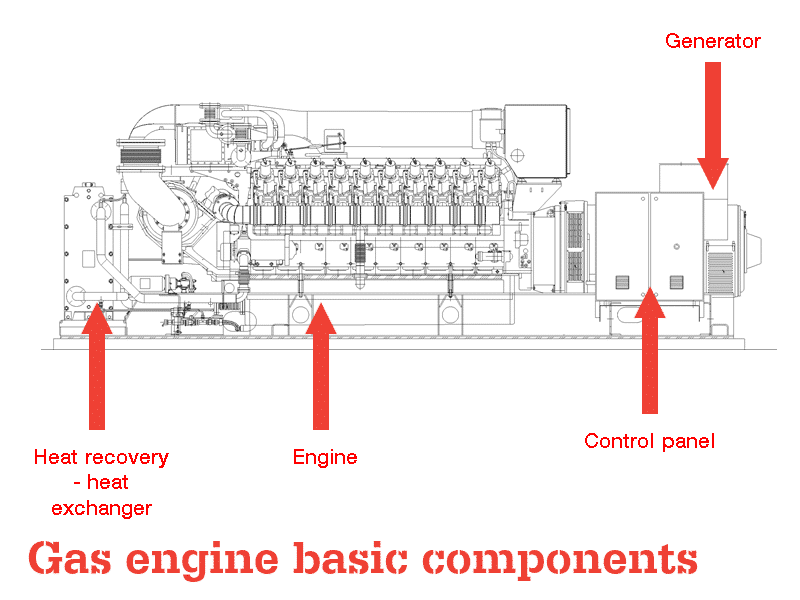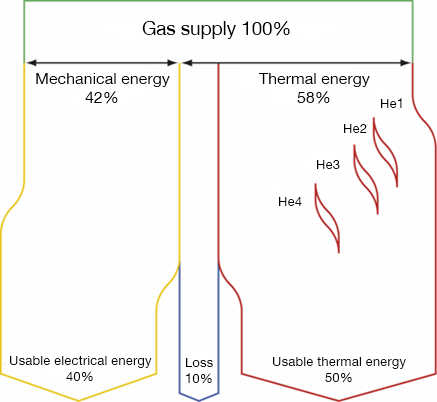Combined heat and power plant efficiency is a function of the conversion efficiency of the energy in the fuel gas to useful energy in the form of electricity and heat.
A combined heat and power (CHP) plant is typically a reciprocating gas engine that uses the energy in the gas to drive a crank shaft. The crank shaft turns an alternator to produce electricity. Heat is released during the gas combustion process. This heat can be recovered during cogeneration in order to maximise the heating value of the system.

To understand a biogas plant’s combined heat and power plant efficiency one must first understand the energy content of the fuel gas.
Gas heating value
There are different definitions of the amount of energy stored within the gaseous fuel:
The Lower Heating Value (LHV) or Lower Calorific Value (LCV)
The Higher Heating Value (HHV) or Higher Calorific Value (HCV)
Hydrocarbon fuels typically exist associated with a given amount of water. Also when the fuel is burnt one by-product of the combustion process is water. The quantity of water produced is a function of the amount of hydrogen in the fuel gas. Due to high combustion temperatures, this water takes the form of steam. Steam stores a small fraction of the energy that is released during the combustion process; this is the latent heat of vapourisation (heat stored in the vapourised state of water)
The total amount of heat liberated during the combustion of a unit of fuel, the HHV (HCV), includes the latent heat stored in the vapourised water. This vapourised water (and hence energy) is released in the exhaust gases of the engine.
The amount of heat available from a fuel after the latent heat of vapourisation, the LHV (LCV), is deducted from the HHV. The LHV is the energy available to a gas engine and it is that which conversion efficiency is calculated.
The LHV of a fuel determines the fuel flow rate required when going into the gas engine because the total quantity of energy input necessary for the engine to produce a specific output power is defined and fixed. Hence the gas flow rate has to be such in order to provide the required energy input.
Fuel LHV is normally quoted using units of kWh/Nm3, if the energy input to the engine is calculated is known, the gas flow rate in m3/hr can easily be calculated.

Energy conversion and biogas CHP plant efficiency
The conversion efficiency of a combined heat and power plant can be defined as
Electrical output from an alternator + utilised thermal output from gas engine
Divided by
Energy input to gas engine based upon LHV of gas
X 100
Alternatively it is defined as the electrical efficiency of the CHP plus, the thermal efficiency of the CHP.
Before conversion into electrical efficiency the energy in the biogas must first be converted into mechanical electricity. There is a small amount of loss during this process.
Gross electrical efficiency is straight forward to calculate. For a high efficiency Jenbacher biogas engine this can reach 43% depending upon the model and electrical output.
There are a number of points where heat can be recovered from a gas engine:
The intercooler, lube oil and jacket water heat is typically combined in a cooling circuit. This heat is typically available as hot water via a plate heat exchanger on a 70/90°C flow/return basis.
The exhaust gases on biogas engines are released at ~450°C. These gases can be passed into an exhaust gas heat exchanger to recover this energy as supplementary hot water.
(Note for biogas engines, the exhaust temperature is typically not dropped below 180°C in order to prevent the condensation of corrosive acid originating from sulphur in the fuel gas)
In addition to the above heat sources, further heat can be recovered from the 2nd stage intercooler. However this is not common, as this heat is low grade at 55°C and is difficult to utilise.
The table below shows an example of the cumulative system efficiency of a gas engine. If a less electrically efficient model is used, over-all efficiency can be in excess of 90%. However the relative commercial value of the electricity is typically much higher than that of the heat, and hence the drive is for more electrically efficient engines.
| Energy MW | Cumulative efficiency | |
| Energy content of fuel gas (LHV) | 3.526 | |
| Mechanical output | 1.527 | |
| Electrical output | 1.489 | 42.2% |
| Intercooler 1st stage | 0.261 | 49.6% |
| Lube oil | 0.158 | 54.1% |
| Jacket water | 0.427 | 66.2% |
| Exhaust gas cooled to 180°C | 0.605 | 83.3% |
| Intercooler 2nd stage | 0.076 | 85.6% |
| Dissipated heat | 0.108+0.035 | 14.3% |
In summary the efficiency of a combined heat and power plant can be calculated by understanding the efficiency of conversion of the energy in the fuel gas, into useful power in the form of electricity and heat.
Connect with Clarke Energy
www.linkedin.com/company/clarke-energy
www.twitter.com/ClarkeEnergy
www.facebook.com/ClarkeEnergy




